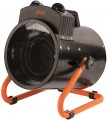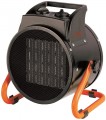Rated current
The current consumed by the heat gun during normal operation. This parameter is useful primarily for assessing the load on the mains that occurs during the operation of the unit and organizing the appropriate connection. In particular, the rated current of the fuse installed in the connection circuit cannot be lower than the total rated current of the connected load — otherwise, the power will be turned off. Heat guns (primarily electric, see "Power supply") are quite high consumption consumers in terms of current.
Power consumption
The power consumed by the electrical components of the industrial heater during operation.
This parameter allows, first of all, to assess the load on the power grid and the suitability of the available power for the normal operation of the unit. It is relevant for all types of modern industrial heaters (see "Power supply"). However, it is worth noting that in some electric models, the power consumption is indicated for the ventilation mode. In this mode, the heating element is not activated, and the power consumption is extremely low — a few tens of watts. In such cases, the total power can be estimated from the maximum thermal output (see above) — in electrical models, these parameters practically do not differ from each other.
Heating element
—
Open coil. The simplest type of heater for electric industrial heaters (see "Power supply"): a high-resistance metal coil that heats up when an electric current passes through it. open coil heaters are inexpensive, heat up quickly, provide a large increase in air temperature (see above) and generally have good efficiency. At the same time, dust or other contaminants can get on an open heater, which leads to unpleasant odours, intense heating dries the air, and the heating element is characterized by an increased fire hazard and has a relatively short service life (in other words, it burns out quite quickly from contact) with air, moisture and pollution).
—
Tubular heater. The main element of such devices is also an electric heater (see above), but in this case, it is not installed openly but is enclosed in a metal tube filled with a heat-conducting insulating material (for example, quartz sand). Heating elements heat up somewhat more slowly than open coils, and their heating temperature is lower. However, this type of heater is considered more advanced — primarily because the protected heater is safer and more durable. In addition, a low operating temperature also has its advantages — a large temperature difference at the inlet and outlet is not always convenient, and there are fewer unpleasant odours when the heating element is contaminated.
—
Ceramic.
...The most advanced type of heaters for electric type industrial heaters. Usually, such elements have the form of a series of plates made of special ceramics with high thermal conductivity. Due to this, it is possible to ensure high heat transfer efficiency at low operating temperatures, due to which ceramic heaters do not burn dust and dirt, practically do not create unpleasant odours, and the effect of drying the air from them is not so noticeable. On the other hand, such equipment is expensive.
— Heat exchanger. A type of heater that is used only in water models (see "Power supply") and diesel units of indirect heating (see "Type of diesel heater"). In the first case, the heat exchanger is a circuit through which heated water or other coolant passes, in the second — a combustion chamber of a special design. Anyway, the air passing through the heater is heated by contact with the outer walls of the heat exchanger. To increase the contact area and increase the heating efficiency, these walls often have a complex shape — with ribbed protrusions, plates, etc.
— IR plate. Specially designed plate that transfers heat primarily by infrared radiation. For several technical reasons, it is used only in diesel industrial heaters, and, unlike traditional units, these models do not have a fan. It is because IR radiation does not heat the air, but directly the objects that are under it, so there is no need to provide air circulation. IR heaters are convenient in cases where you need to heat only a relatively small area in a large room; in addition, they can be effectively used even outdoors, where the heat from traditional industrial heaters would simply be dissipated into the atmosphere.Airflow
The maximum amount of air that an industrial heater can pass through itself in a certain time.
This parameter is associated with an increase in air temperature (see above): at constant power, higher performance usually corresponds to a smaller temperature difference. Accordingly, a more efficient industrial heater will heat the entire volume of the room faster, but the heating temperature will be lower. So, it is worth choosing according to this parameter, taking into account what is more important for you — a large temperature difference or a high heating rate.
Power adjustment
The method of adjusting the heating power provided in the design of the heat gun.
- Stepped. Step adjustment assumes the presence of several fixed power values, between which switching is carried out during the tuning process. The accuracy of such a setting is worse than that of a stepless one (see below), even in cases where there are quite a lot of fixed values. At the same time, perfect accuracy is far from always required, and setting a specific value is easier than selecting the position of the regulator with stepless adjustment.
-
Stepless. Stepless systems include adjustment systems that do not have fixed steps and allow you to set the power value in any range from minimum to maximum. Due to this, this setting is extremely accurate, although in some cases it is not as convenient as the stepped one described above.

